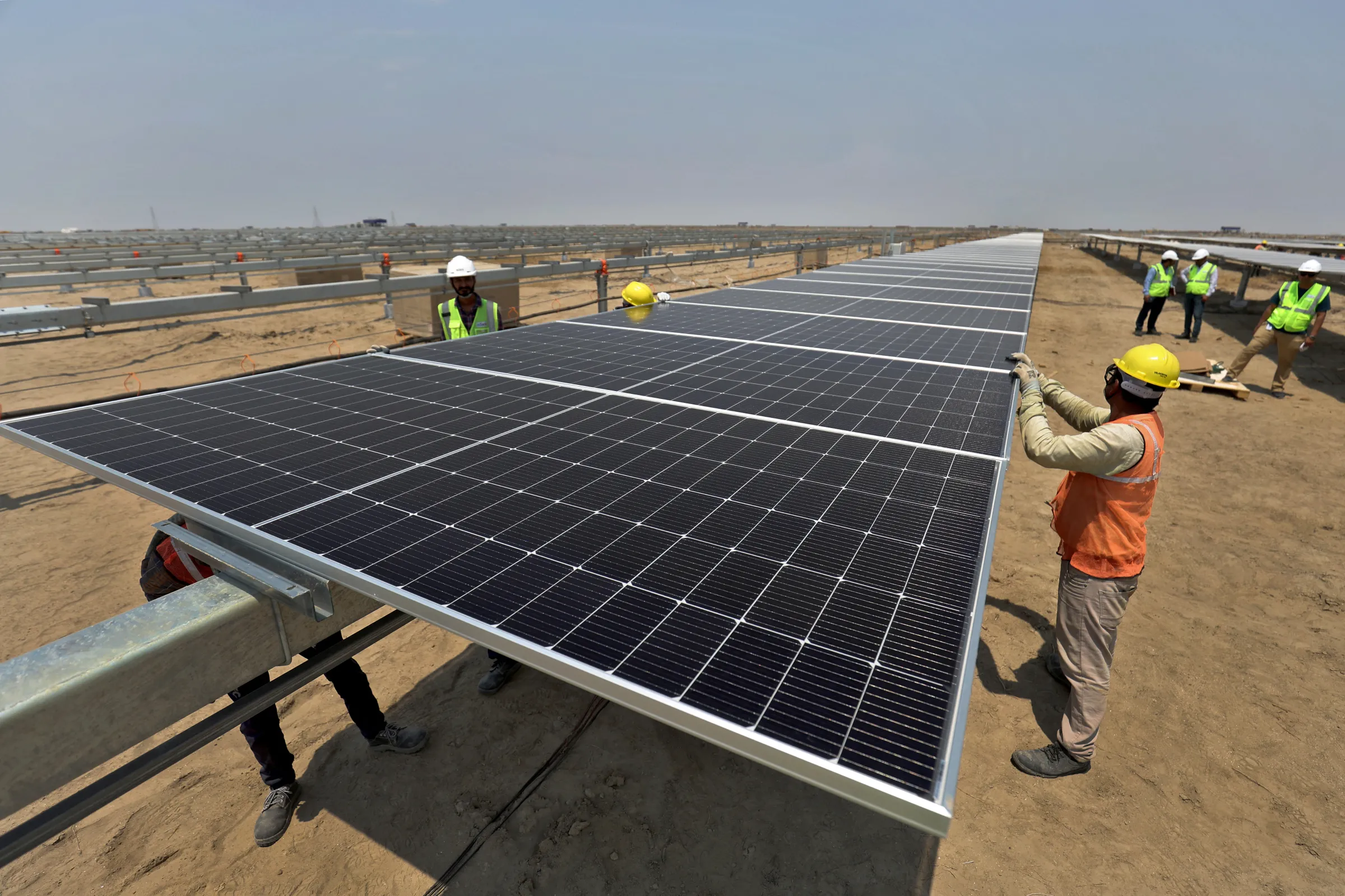India-EU Bonhomie: A crucial alliance amid global uncertainties

Workers install solar panels at the Khavda Renewable Energy Park of Adani Green Energy Ltd (AGEL) in Khavda, India, April 12, 2024.REUTERS/Amit Dave
European Union President Ursula von der Leyen’s visit comes at a crucial time to strengthen the EU-India strategic partnership.
Aarti Khosla is the founder and director of Climate Trends, a Delhi based climate think tank
In 1962, India made a pivotal move by becoming one of the first nations to establish formal relations with the European Economic Community (EEC). This laid the foundation for a relationship based on shared values and principles of democracy, rules-based international order, multilateralism, and sustainable development. The importance of this partnership is even more pronounced today as the world adjusts to shifting alliances and diplomatic approaches.
Central to these changes are the rise of transactional relations between countries, coupled with the shift toward more conservative administrations. This change could strain long-standing military alliances, like that between the US and the EU, while creating challenges in areas such as market access, tariffs, taxes, and labor issues. The evolving global context offers a unique opportunity for the EU and India to reaffirm their mutual commitments.
Since the 2015 Paris Agreement, India has become not only an economic power but also a leading advocate for collaboration and a rules-based international order. Its leadership in the Global South is built upon the extensive array of examples rooted in practical climate action and policies that align with its development priorities and constraints.
Given this, European Union President Ursula von der Leyen’s focus on India and her plan to strengthen the EU-India strategic partnership, alongside her current visit with the entire college of EU commissioners, comes at a crucial time. The visit will offer a platform for collaboration on sustainable energy, trade, climate resilience (including trilaterals with African states), science, technology, and agriculture in a just and equitable manner. It will also reinforce the relationship based on common but differentiated responsibilities.
India’s National Green Hydrogen Mission, aligned with the EU’s decarbonization goals, aims to produce 5 million metric tonnes (MMT) of green hydrogen annually by 2030. This initiative has the potential to reduce India’s emissions by 50 MMT per year. With joint research, investments, and EU technological expertise, barriers such as high production costs and low demand could be effectively addressed.
India has already installed 217.62GW of its planned 500GW of non-fossil fuel energy capacity by 2030. The country is also building smart cities, integrating more renewable energy, and modernizing its grid. With energy demand set to grow more than two times by 2047, this offers the EU an opportunity to leverage its renewable energy expertise. Collaborating through initiatives like the EU-India High-Level Platform on Smart Grids to help drive innovative solutions, such as improving grid resilience.
India’s e-mobility targets – 30% EV sales in private cars, 70% in commercial vehicles, 40% in buses, and 80% in two- and three-wheelers by 2030–are ambitious for a developing country. Both blocs are already members of the Minerals Security Partnership (MSP), and the India-EU Trade and Technology Council (TTC) signals increased technological cooperation and minimizing vulnerabilities in this vital sector, while reducing dependence on China. Collaboration on resilient supply chains and technology is a natural step for both parties.
Trade is another avenue for deeper cooperation. Bilateral trade grew from €92 billion in 2018 to €120 billion in 2022, with the EU being India’s third-largest trading partner in 2023. India also attracts significant EU foreign direct investment in sectors like renewable energy, digital technologies, manufacturing and pharmaceuticals. With initiatives like the India-Middle East-Europe Economic Corridor (IMEC), launched during the 2023 G20 summit, is an example of how the two partners can further boost trade.
In light of global upheavals, it is critical that India and the EU finalize a comprehensive free trade agreement (FTA). Negotiations for this agreement resumed in 2022 after a near-decade-long hiatus. Both economies should make concessions to achieve a meaningful, ambitious, and fair agreement. India offers strengths in manufacturing, services, and a cooperative, non-aligned model of engagement.
A key issue to address is the Carbon Border Adjustment Mechanism (CBAM), which is expected to significantly impact India’s export earnings, particularly in iron, steel, and aluminum products. In 2022, 27% of India’s exports of these products worth $8.2 billion went to the EU. India has been critical of this mechanism, as it could create an uneven playing field. The negotiations must consider India’s significant contributions to climate action.
In conclusion, the world is closely watching India’s unprecedented growth as it navigates global challenges to secure energy, meet development goals, and lead in fostering a sustainable, just and equitable future. The India-EU partnership holds immense potential to drive progress in critical areas for a greener, more prosperous future. The focus should be on leveraging each other's strengths and working together to meet the aspirations and priorities of both regions.
Any views expressed in this opinion piece are those of the author and not of Context or the Thomson Reuters Foundation.
Tags
- Clean power
- Adaptation
- Net-zero
- Climate policy
Related
Latest on Context
- 1
- 2
- 3
- 4
- 5
- 6














